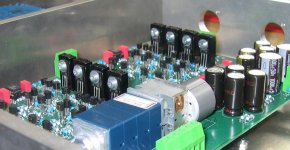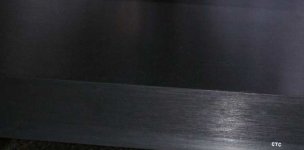I use SPL meters in an attempt to set playback levels to record levels. As I understand them, VU meters measure decibels of the electrical signals (post electro-mechanical transducer in the case of recording, and pre, in the case of playback). VU meters are an aid to adjust record levels to prevent clipping (distortion).
-
Using time-averaged levels, I'd like to find a means to correlate VU readings (or the like) to SPL readings. Of course, transducer response and room acoustics are large factors.
.
-
Using time-averaged levels, I'd like to find a means to correlate VU readings (or the like) to SPL readings. Of course, transducer response and room acoustics are large factors.
.
Last edited:
The Blowtorch does not have a power switch to avoid using signal switch/relay contacts for power on mute?
.
.
Last edited:
Hi John
I think I understand what you are implying here with your your Vu meter analogy and I agree with it entirely based on what I read at the TNT website.
However I have some experience with dither that is used in controlling servo-hydraulic machines for fatigue testing of materials. In this application it has the complete opposite effect. I wish I knew (it looks like I have something to read about now) exactly what the dither is doing to improve the response of the machine so I could comment further. However I could probably post some pictures to demonstrate how it improves the response. I don't know if this could be applied to audio in the same way it used in the servo hydraulic machine, but if it can, it definitely is worth looking into.
I think I understand what you are implying here with your your Vu meter analogy and I agree with it entirely based on what I read at the TNT website.
However I have some experience with dither that is used in controlling servo-hydraulic machines for fatigue testing of materials. In this application it has the complete opposite effect. I wish I knew (it looks like I have something to read about now) exactly what the dither is doing to improve the response of the machine so I could comment further. However I could probably post some pictures to demonstrate how it improves the response. I don't know if this could be applied to audio in the same way it used in the servo hydraulic machine, but if it can, it definitely is worth looking into.
Hi John
I think I understand what you are implying here with your your Vu meter analogy and I agree with it entirely based on what I read at the TNT website.
What VU meter analogy was that? I don't see where John made any sort of analogy to a VU meter.
I made an impromptu "cognitive dissonance" meter in response to one of SY's posts and then John asked if anyone had ever seen or used a VU meter.
Where exactly was the analogy?
se
I read his mind. He hasn't shared the analogy yet.
I could be way off track with what he is trying to say here.
I could be way off track with what he is trying to say here.
Last edited:
Well, I noted that a continuous +3 on a Vu meter shows somebody not knowing how to make a proper recording. It looked silly to me, even though it meant something else. Nothing really hidden or that important.
I read his mind. He hasn't shared the analogy yet.
I could be way off track with what he is trying to say here.
I haven't seen any evidence that he's trying to say anything with regard to VU meters.
What TNT article are you referring to?
se
Dither article
That Dither Thing - [English]
Yes it works well if the intended signal is a sine wave.
What if the intended signal was a stepped sine wave as pictured would it still smooth the signal to a sine wave
That Dither Thing - [English]
Yes it works well if the intended signal is a sine wave.
What if the intended signal was a stepped sine wave as pictured would it still smooth the signal to a sine wave
It works with her voice, too.
I can testify that said voice, while sinuous, is not a sine.
An externally hosted image should be here but it was not working when we last tested it.
I can testify that said voice, while sinuous, is not a sine.
You'll recall the fellow who, despite being quite intelligent, just could not get the concept of how S/N of a 16 bit system was calculated...
<snip>
Nevertheless the _exact_ calculation of S/N of any sampling system with restricted quantization is not that easy, as it depends on sampling rate, calculation bandwidth, number of bits, signal content.
@ scott wurcer,
i think pavel meant it in a strict sense, as the number of bits gives the number of differentiable steps. So the resolution of an for example 16 bit system would only be higher after application of dither if the number of steps would be higher.
It works with her voice, too.

I can testify that said voice, while sinuous, is not a sine.
I am sure it sounds nice but is it accurate?
Of course, dither 'works' Werner. Look at those sine waves that got cleaned up.
That´s it. Take 128K samples, 100x averaging, and what a "S/N" we have! (with sine) 😀
Last edited:
not a power switch ?
What's in a Name if it's not turned on all the time ? (supposing there is a turn-on thump without a mute)
Cthicks with no knobs can be vogue too.
Baldispre, Disbalpre, Disprebal ?
Attachments
Historically speaking, and iirc, people were making and selling modules that strapped on the back of "VU meters" that were active electronics and did the peak sample and hold trick - in effect correcting the inability of the VU meter to show transient peaks... which when tape could be saturated by a bit was not such a big deal, but when folks started trying to push that medium and make sure that they didn't hit it too hard became something of an issue... again, iirc...
_-_-bear
_-_-bear
Bear wins the prize! He said something useful about Vu meters. Thank you Bear. Seeing the Vu meter 'pinned' like that reminds me of trouble, just like if you had an RPM meter in your car stuck at maximum. I wasn't sure if there was another 'alternate' peak reading standard that was calibrated to look like a Vu meter superficially.
Don't really know what VU meters have to do with the discussion. But if anyone wants to know more about them, here is the seminal paper on the subject, published in 1940.
A New Standard Volume Indicator and Reference Level
se
A New Standard Volume Indicator and Reference Level
se
Seeing the Vu meter 'pinned' like that reminds me of trouble, just like if you had an RPM meter in your car stuck at maximum.
That was the point I read into Steve's original post.
Anyway, my previous posts notwithstanding, I would actually like to see some on topic posts in this thread.
- Status
- Not open for further replies.
- Home
- Member Areas
- The Lounge
- John Curl's Blowtorch preamplifier part II

